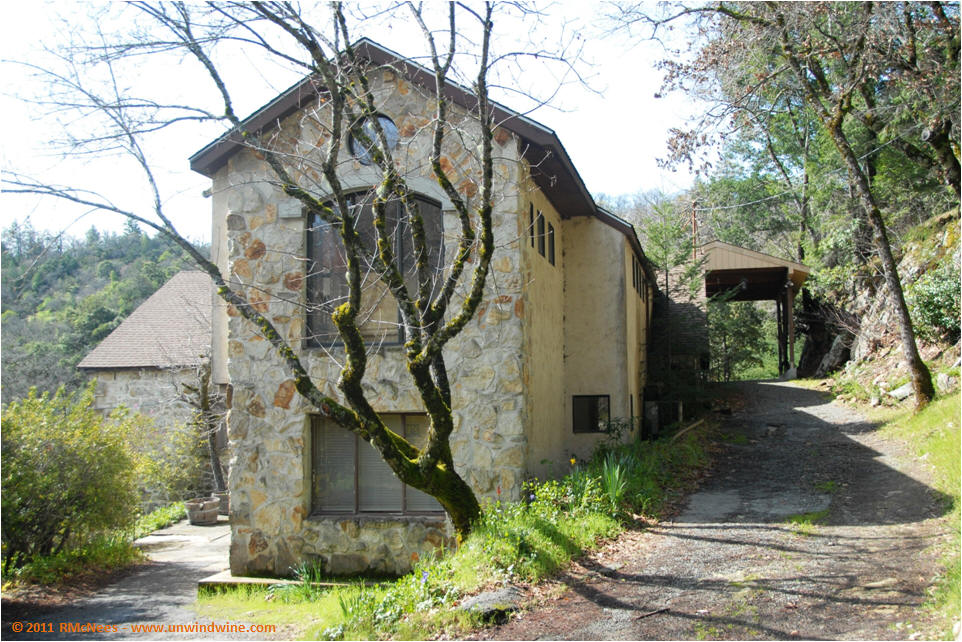Hidden Ridge 55 Degree Slope Sonoma Valley Cabernet Sauvignon 2009
I pulled this from the cellar to have with pizza, and wow, what a combination. This wine was bigger, bolder, brighter and more expressive than I remember from earlier tastings - a great pairing with zesty pizza!
This is from Hidden Ridge Vineyards which is located in rugged mountainside terrain, as the name indicates, between Mount Hood and Diamond Mountain in the Mayacamas mountain range that separates Napa Valley to the east and Sonoma Valley to the west.
Hidden Ridge Vineyard was founded by the husband and wife
team Lynn Hofacket and Casidy Ward who bought the property
back in 1991. The location is so remote that you can only access it by four
wheel drive, by foot or by helicopter. Lynn spent six years terracing the 55 acres
and planting the vineyard while taking courses on viticulture at Santa
Rosa University.
The estates vineyards fall between the range's 'saddles' creating some of the most
dramatic vineyard sites on the Sonoma side of the summit crest of the mountain. It lies near the mountaintop estates of Pride , which actually straddles the summit therefore lying in both Sonoma and Napa, and Paloma Vineyards, near Pride on the Napa side, high atop Spring Mountain. The
vineyard sits at elevations of 900 – 1700 feet, making it among the
highest elevation vineyards in either Napa or Sonoma.
The terraced vines are on a steep mountainside in a valley with eastern, southern and northern exposures and the typical decomposed granite and alluvium soils of the Mayacamas Mountains. The vineyard site experiences cool mornings and evenings and moderate temperatures during the day that allow the fruit to hang for a long time without over-ripening. The soils and the steep slope contribute to the vineyard’s drainage and to the tannic structure of the fruit, giving it a big, brawny structure that mountain vineyards are known for.
Hidden Ridge Vineyards is comprised of 55 acres, with approximately 46 acres in Cabernet, 1 acre in Petite Verdot and 1 acre in Chardonnay. The Cabernet planted in in 21 different blocks.
The winemakers for this release were Marco Di Giulio, consulting winemaker to several leading Napa labels, and of his own label of which we hold several vintages in our cellar from 2001 through 2004, and Timothy Milos.
Lynn and Casidy hired Timothy Milos as consulting winemaker. Timothy grew up in the Bay Area and did undergraduate studies in Cell Biology at U.C. Berkley and Sonoma State University, then earned a graduate degree in Plant Pathology at Cornell University. He studied winemaking at the UC Davis Masters Program. He worked at wineries in New York’s Finger Lakes district before returning home to California where he did stints at such notable producers Opus One, Stag’s Leap Wine Cellars and Cliff Lede.
"That's some good grape dirt up there," Oklahoma native and owner Lynn Hofacket points out eyeing his property. Adds winemaker Marco Di Giulio, "A vineyard so steep, so well developed, so interesting in its planning scheme and with so much vision behind it that I could not help but be blown away. I bring my other winemaker friends out there because I like to see the awed expressions on their faces. Yeah, it's really that amazing."
I first discovered this wine at Morton's Steakhouse in Crystal City, Arlington, near Washington DC where it was available by bottle or by the glass. During the ensuing years we enjoyed the 05, 06 , 07 and then this '09 vintages there. We also picked up the '05 at BRIX in Napa and tasted at dinner during our Mt Veeder appellation trip in the Napa and Sonoma Mt Veeder area.
Hidden Ridge has since been taken over by new owners Timothy Martin and Randy Nichols. Timothy Milos continues as winemaker.
Timothy Martin spent two accomplished decades in restaurant and hospitality management, then worked with legendary producer Robin Lail, and her wine project, Lail Vineyards. He worked there helping establish the Lail brand for ten years, then launched Gauge Branding, a marketing company in 2004 with partner Mark Wiegard.
In 2008, he began a joint venture, Tusk Estates, with his friends Michael Uytengsu and Philippe Melka with a goal to create the next great luxury wine brand.
Partner Randy Nichols traveled to the Napa & Sonoma valleys for 30 years before discovering Immortal Estate. Founder of the Nichols Partnership, he specialized in commercial and multi-family real estate.
Hidden Ridge was rebranded into Immortal Estate and produces ultra-premium highly allocated labels "Slope" and "Impassable Mountain".
In 2014, Wine Spectator rated this 2009 “55% Slope” #32 of the Top 100 Wines of the year.
The 2012 “Impassable Mountain Reserve” achieved a
97 points from Robert Parker and in March 2016, received a perfect
score of 100 points by Robert Parker. The 2013 sells on the website to members only for $375.
Hidden Ridge 55 Degree Slope Sonoma Valley Cabernet Sauvignon 2009
Robert Parker's Wine Advocate said "this stunning 2009 is one of the finest Sonoma County Cabernet Sauvignons ever produced. Drink it over the next 15+ years."
Wine Enthusiast said, "Give it until at least 2017." Wine Spectator said, "Drink now through 2024."
My previous tasting of this label were in 2014 and before that, my review and blogpost in 2019 and I must say, tonight this blew me away, exceeding expectations set by those earlier tastings. This appears to be just hitting its stride at fourteen years and is the best I've had from this producer to date.
The label, foil level and most importantly, the fill level and cork were all perfect.
Dark garnet colored, full bodied, deep, rich, intense, concentrated expressive blackberry, black raspberry and black cherry fruits with notes of licorice, dark mocha chocolate, tobacco, cedar, hints of charcoal, truffles, and graphite with firm, structured but approachable tannins and nicely balance acidity on a long firm polished finish.
RM 93
https://www.cellartracker.com/wine.asp?iWine=1768006
http://unwindwine.blogspot.com/2014/04/hidden-ridge-55-degree-slope-cabernet.html
Hidden Ridge is now -





























